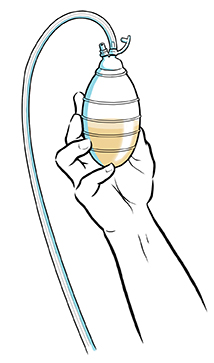Mastectomy: After Surgery
The length of your hospital stay depends on the type of surgery you have. You’ll be given instructions to follow during recovery. The amount of time needed to fully recover varies from person to person. It's normal to be very tired the first week or two. Try to be patient with yourself as you heal. Take the time you need to adjust to the changes in your life and body.
Right after surgery
You'll wake up in a recovery room, where you'll be closely watched. You will have an IV (intravenous) line for medicines and fluids. Once you're fully awake, you'll be taken to a hospital room, where you can have visitors. You may need to stay in the hospital for a day or two.
Expect to be up and walking soon after surgery. You'll be given pain medicine if you need it. It's important to get out of bed and move around, even though it may be hard to do. Activity can help get your digestive tract moving, help prevent blood clots, and help get air moving normally through your lungs. Use the pain medicine to be comfortable so you can get up.
Your first look
You will have bandages on your chest after surgery. You may go home with bandages. Or they may be removed before you leave the hospital. Looking at your incision for the first time can be hard. You may feel most at ease taking this step at home. You may want to be alone, or you may want family or a friend to support you. Either way is OK. At first, try looking down at your body rather than in the mirror.
There will be some bruising, redness, stiffness, tightness, and swelling that will get better as you heal. It can take up to a year for you to fully heal and know what your chest will look and feel like.
At home
 |
| Remove the plug and measure the fluid as directed. |
 |
| Once the drain is empty, squeeze the bulb with one hand while using the other hand to replace the plug. |
Plan on having someone stay with you for a few days after you go home. You'll be given some prescription medicines to take. Make sure you know what they're for and when to take them.
Before leaving the hospital, you'll be taught how to take care of your incision. You may have:
-
One or two soft plastic drains. These draw off fluid from behind and around the incision. Be sure to empty your drain at least every 8 hours, or as directed. Remove the plug and empty the contents into the container provided. Measure the amount of fluid as directed. Write it down to show your healthcare provider. The fluid may look bloody or yellow. Flush it in the toilet, rinse out the measuring container, and let it air dry until next time.
The drainage will decrease as you heal. The drains will be removed in your surgeon's office.
-
A bandage (dressing) over your incision. Care for the dressing or bandage as directed. You may have an elastic wrap that goes around your chest to help hold it in place. Take sponge baths at first to prevent getting your bandage wet. Your healthcare provider will tell you when it's OK to take off the bandage and when it's OK to stop using one.
-
Stitches at the incision site. They may dissolve on their own. Or they may be removed at your follow-up visit. Ask your provider what to expect.
-
Pain medicines to help relieve any discomfort. Medicines should be taken as directed. Ask what side effects you should watch for and what you can do to help prevent them.
-
An activity or exercise plan. Make sure you know what you can and can't do. You'll be given exercises to help regain normal movement in your shoulder, build your arm and chest muscle strength, and help decrease swelling. This is an important part of your recovery.
-
A follow-up appointment. Find out when you'll need to see your provider next and what to expect as the next part of your treatment.
Talk with your healthcare provider about what problems to look for and when to call them. Know what number to call anytime you have questions or problems, including after office hours, on weekends, and on holidays.